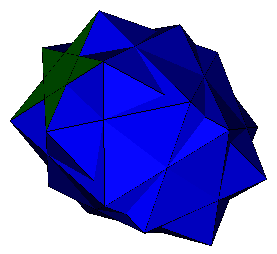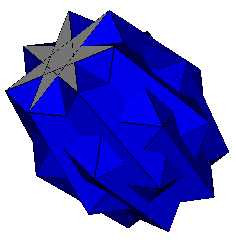

Snub Anti-Prisms
This is an infinite family of 2-uniform polyhedra where a base polygon (an n-gon) is surrounded by vertices of the form n.3.3.3.3, the snub vertices are then of the form 3.3.3.3.3 Substituting 2 for n gives the Johnson Solid snub disphenoid, {3} is a regular icosahedron, {4} is the Johnson Solid snub square anti-prism and {5} is a snub pentagonal anti-prism, however this last example is noticeably not convex. Note: The n-gonal members of this family are briefly discussed in Professor Bonnie Stewart's "Adventures Among the Toroids" 2nd Ed. Ex 115 on page 160.
Substituting an n/d-gon for the n-gon in the above extends the family to allow an infinite number of locally convex polyhedra (in the sense that no dihedral angle is > pi). If this is not obvious from the images above take a look at this cutaway model of a 7/3 snub anti-prism where only one rotation of the triangular faces around the prismatic axis of symmetry is shown.
These polyhedra are generated from the anti-prisms by dividing the anti-prism into two portions, each of which consists of the base n/d-gon and it's edge connected triangular faces. A ring of snub triangles is then inserted between these two portions. This is evident in this example of a highlighted 5/2 snub anti-prism with the snub triangles in yellow.
The upper bound for local convexity is at n/d = 4.7445... Click here for proof. Cases generated around this limit include 4.5 (see 9/2), 4.666 (see 14/3) and 4.75 (see 19/4). Only the first two are convex.
A full table of locally convex
snub
anti-prisms with d>1 and n<=12 is below.
| Snub Anti-prisms: | 5/2
|
7/2
|
7/3
|
8/3
|
9/2
|
9/4
|
10/3
|
11/3
|
11/4
|
11/5
|
12/5
|
Snub anti-prisms also exist for n/d<2. The lower limit is undetermined. In these cases the base polygon is retrograde. In general the retrograde n/(n-d) snub anti-prism is isomorphous to the n/d snub anti-prism. Examples of retrograde snub anti-prisms are given here: 7/4, 7/5, 5/3, 3/2, 10/7, 4/3, 5/4 [1]
As the icosahedron is a member of this family, the various isomorphs to the triangular snub anti-prism also occur in this list of isomorphs to the icosahedron.
The snub anti-prisms can be gyro-elongated by the insertion of a band of triangles between the two halves of the snub anti-prism. This generates a family I term the pentakis pentaprisms. They can also be deformed into anti-prisms and gyrobicupolas - see 'Twisters'.
A family also exists of "great" snub anti-prisms, an example of the 7/3 great snub anti-prism is shown above. These polyhedra are isomorphous to the snub anti-prisms but have starred vertices. They have the same relationship to the snub anti-prisms as the great icosahedron has to the icosahedron. Indeed the great icosahedron is a member of this family and can be regarded as a "triangular great snub anti-prism".
A
table of those generated
to date with n/d>2 is as follows:
| Great Snub Anti-Prisms: | 4
|
5 [1] | 5/2
|
7/2
|
7/3
|
8/3
|
9/2
|
9/4
|
10/3
|
11/3
|
11/4
|
11/5
|
12/5
|
Great snub anti-prisms exist for n/d<2, the retrograde base polygons then having the effect of partially un-crossing the starred vertices. Examples are the 3/2, 4/3, 5/3, 7/4, 8/5 and 5/4 [1]. Note the triangular edges on the 4/3 example are coplanar with the square faces.
Exotic Snub Anti-Prism Isomorphs
Two additional isomorphs exist for certain ranges of n/d. These are (a) the hybrid snub anti-prisms and (b) the inverted snub anti-prisms. Both families have pyramidical rather than prismatic symmetry and are 4-regular polyhedra.
The hybrid snub anti-prisms are so named as they have the appearance that one half of a pro-grade n/d snub anti-prism is joined to one half of its retrograde n/d* twin. For example the 5/2-5/3 hybrid (above) the 7/3-7/4 hybrid or the 8/3-8/5 hybrid. The limits of this 'hybrid' family are undetermined. The hybrid 3-3/2 snub anti-prism also exists and is synonymous to a tri-inverted icosahedron. (see isomorphs to the icosahedron). This is apparent by examination of this 4-4/3 hybrid.
The inverted snub anti-prisms are so named as one of the half snub anti-prisms is inverted back into the centre of the figure, meaning that the {n/d}-gonal cap is predominantly hidden. For example this 4, 5/2 or 7/3 example (above). The limits of this 'inverted' family are undetermined. The inverted triangular snub anti-prism also exists and is synonymous to a tri-everted great icosahedron. (see isomorphs to the icosahedron)
An unexpected coplanar case [2]
With the size of the base polygon, the two bases move closer together, at n=9 they have reached a point where the edge connected triangles are coplanar with the base, the enneagonal snub antiprism is shown on the left above (VRML, OFF). Coplanarity is also evident in the 9/7 snub anti-prism (above right) (VRML, OFF) where the edge connected triangular faces are coplanar with the 9/2-gonal caps but are now pointing inwards. (Note: the 9/2-gons in this model have been coloured blue to avoid migraines when viewing the VRML file).
Notes and acknowledgements
[1] I am indebted to Adrian Rossiter, developer of the Antiprism software for the generation of the great 5, the 5/4 isomorphs, and the generation of the coplanar 9 and 9/7. Adrian has developed software to generate an arbitrary isomorph of any n/d snub anti-prism and has also generated two fascinating animations of the {101/d} antiprism for varying d. The files are around 6MB each, see www.antiprism.com/misc/snu101_s0.gif (snub anti-prisms) and www.antiprism.com/misc/snu101_s1.gif (great snub anti-prisms).
[2] The coplanarity of the {9/7} snub anti-prism was discovered by Roger Kaufman, that of the {9}-snub anti-prism by Adrian Rossiter.